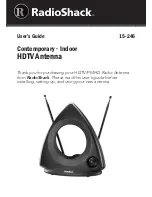3
0.5 dB), in vertically polarized measurements cable position can effect results, so it is
recommended that the cable be suspended horizontally back from the antenna at least 1
meter before any vertical drop. Below 150 MHz, bow-tie radiation dominates with a
dipole-like pattern, while above 150 MHz the radiation in the plane of the elements is
directional. The antenna has a mounting bracket and 1/4x20 UNC knob for attaching to
EMCO tripod and tower adaptors. Individual antenna factor calibration data is included
with each antenna. The Model 3141 can be used with or without the end frames of the T
bow-ties. However, calibration data is valid ONLY with the T bow-ties intact.
The unique feature of the Model 3141 is the T bow-tie elements. A T bow-tie
increases the equivalent dipole electrical length, thereby decreasing resonant frequency
and increasing efficiency in the 20-60 MHz range. Similarly, a regular bow-tie has a
lower resonant frequency than an equal length single-wire dipole. The T bow-tie has its
first resonance at a frequency where its length is about 0.22
λ
, a regular bow-tie at a
length of 0.3
λ
, and a tuned dipole at about a length of 0.48
λ
. Thus at 50 MHz the 1.4 m
long T bow-tie of the Model 3141 behaves like a 2.8 m tuned dipole. Cross-polar
radiation is minimized because current flow on one of the T end frames is almost exactly
cancelled by the oppositely-phased current on the other T end.
Archived 3/18/10


















